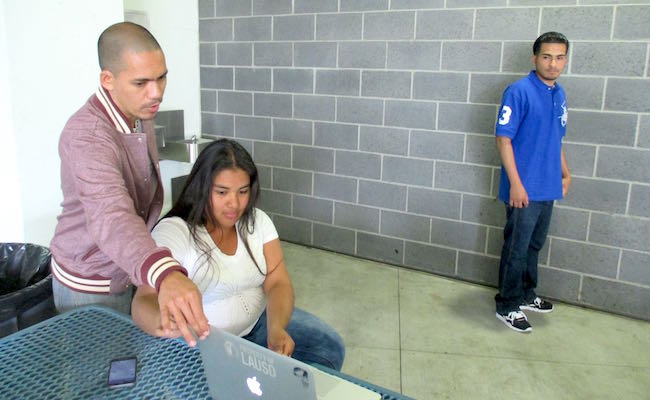This article was produced for Watts Revisited, a multimedia project launched by the USC Annenberg School for Communication and Journalism that explores challenges facing South L.A. as we commemorate the 50th anniversary of the 1965 Watts Riots. Learn more at www.wattsrevisited.com.

Jay Davis stands in front of his class at Augustus Hawkins High School. | Photo by Anna-Cat Brigida
When Jay Davis talks to his students about the 1965 riots, which broke out all around his South L.A. campus, he wants to make sure it is not just a history lesson. Instead, he pushes his students to use the images to talk about the history, understand the factors that provoked rioting and decide what role they would play in history.
Davis, wearing jeans and a maroon varsity jacket, stands in front of a table strewn with books on Oaxacan protest graffiti and hand printmaking. Behind him he projects images of protestors from 1965 and 1992. These images could easily be from any community of color around the country, from Baltimore to South L.A.
“What do you see?” Davis asks an African American student sitting in the back of the classroom.
“I see a man jumping on a Jaguar,” the student answers, referring to an iconic photo from the 1992 L.A .Riots. “What do you think or wonder?” Davis further prods.
“I wonder why he decided to do that,” the student answers.
With this starting conversation, Davis has introduced his lesson on riots in L.A. He begins with the 1992 riots, well-known to his students. Then he brings up the Watts riots of nearly 50 years ago.
“This just goes to show that the students really need to be prepared for the kind of pressures that ignite these kinds of riots,” Davis said. “They need to critically understand their conditions to avoid this kind of riots.”

A student browses a historic photo album from the Watts Riots. | Photo by Anna-Cat Brigida
Each year students become farther removed in time from the 1965 and 1992 riots as fewer parents and grandparents who witnessed the events are alive to relay their stories to the younger generation. But, location connects these students with history. The riots passed by the current site of the school, Augustus Hawkins High, located near Hoover and Slauson.
Davis’ students are unfamiliar with the story of the day Marquette Frye was pulled over for drunk driving, a crowd formed and rioting began. But it wasn’t just about the one incident, Davis tells them.
The Watts riots were a response to systemic inequalities in the area rather than a single arrest, African American Studies professor at Loyola Marymount University Angela James said.
Police brutality, lack of quality and education, and limited access to housing in L.A. bubbled below the surface until a community reached its breaking point, according to James.
“When we can understand the continuities in what provokes riots, then we will begin to understand the enormous importance of addressing those root concerns,” said James. “It will reoccur until that goal is met.”
Each year, Davis is mindful to incorporate lessons about civil unrest in Los Angeles. Since his class is an arts course, rather than an English, Math or History course restricted by Common Core standards, he has more freedom with his lesson plans.
Learning about the riots of the past can help students understand the protests after the grand jury decision in Ferguson, social media campaigns such as #Icantbreathe, and recent riots in Baltimore.
“Imagine yourself in this point in history,” Davis says. “What role do you play?”

Teacher Jay Davis helps students frame their photo for an assignment on riots. | Photo by Anna-Cat Brigida
To combine digital photography skills— the focus of Davis’ media arts class— and local history— a topic Davis personally feels students should learn— Davis instructs his students to find a compelling photograph from the Watts riots and Photoshop themselves in.
The point of the lesson is for the students to identify with history rather than just be a bystander to the events of the past.
Student Alejandro Alvarez chooses a picture of firefighters extinguishing a burning building as looters grab all that they can.
In the high school courtyard, Alvarez’s friends give him instructions to improve his photo composition. They advise him to move forward and hold the duffel bag he is using as a prop at a slightly different angle. The Macbook rests on a cafeteria table as he snaps a photo.
“The riots meant something,” Alvarez said of his choice to identify with the looters. “It was probably unfair in the eyes of the people.”
Alvarez and his classmates weren’t alive during any of L.A.’s riots, but Davis was.
A sophomore in high school when the Rodney King beating was captured on tape, Davis was playing basketball when the officers were acquitted. Everyone in his neighborhood, which lay just outside curfew zone, tuned in to the live broadcast. They watched helicopters shine their light on Florence and Normandie and the downtown LAPD station. The swelling anger and rage was felt through the airwaves of the live broadcast.
Twenty-three years after the L.A. Riots and half a century after the Watts riots, South L.A. continues to battle issues of unemployment, affordable housing and access to quality education, issues which were discussed in the McCone report shortly after the riot. In Davis’ classroom, he has the power to confront these issues.
To Davis, teaching about these conditions can mean the difference between a peaceful march and six days of destruction resulting in $40 million in property damages, 34 deaths and more than 3,000 arrests.
“This is why I am a teacher,” Davis said. “ So that we can really examine our conditions and see what we can do about it.”
Like Intersections on Facebook, follow us on Twitter and sign up for the Newsletter to stay in the loop on news and views from South L.A. Email reporter Anna-Cat Brigida at [email protected] and follow her @AnnaCat_Brigida.















Speak Your Mind